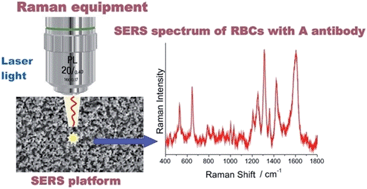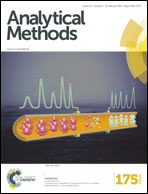ABO blood groups' antigen–antibody interactions studied using SERS spectroscopy: towards blood typing†
Abstract
The article presents surface enhanced Raman scattering (SERS) technique associated with the principal component analysis (PCA) as a fast and reliable method for the study of interactions between the A, B, AB and O (abr. ABO) blood groups antigen and complementary monoclonal A and B antibodies. The possibility of simultaneous detection and differentiation within the ABO group was evaluated. Using 785 nm excitation wavelength, distinctive spectral changes among all types of the studied blood groups were found for mixtures of red blood cells (RBCs) with the A or B antibody. For PCA analysis, all the spectral data were divided into two main groups based on the type of antibody. The obtained PC scores in the area of antigen–antibody interactions (1311–1345 cm−1) allow differentiation within blood groups with accuracy from 96% to 98%. Additionally, for this region the characteristic marker bands of specific antigen–antibody interactions in relation to both ABO system and antibody were established. The results show excellent segregation of the obtained data and the possibility to use SERS for determination of ABO blood group. Our study proves that SERS is one of the most sensitive techniques for investigations of biological samples and may be used as a new tool that provides one-step comprehensive and reliable medical diagnosis.


 Please wait while we load your content...
Please wait while we load your content...